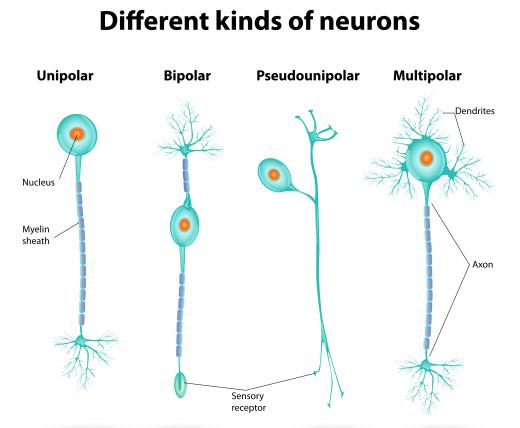What is the Somatosensory Cortex?
 Mary McMahon
Mary McMahon
The somatosensory cortex is an area of the brain that processes input from the various systems in the body that are sensitive to touch. People often think of touch as a single sense, but in fact, several different sensory experiences are involved, including specific sensitivity to pain and temperature, and the proprioception system, which monitors the body's place in space. The somatosensory system as a whole is extremely refined and highly sensitive, allowing people to detect and interpret a wide variety of sensations.
The Somatosensory System

Across the body, a network of nerve cells react when they experience sensations related to physical perception. Specialized cells react specifically to pain, while others fire in response to passing breezes, pressure, and a wide variety of other sensations, such as the heat of the sun or the chill that comes from an open refrigerator. Impulses travel along these nerves to reach a part of the brain called the thalamus, which also deals with information from other senses, such as vision and hearing, and passes the signals on to the somatosensory cortex.
Location and Structure

The somatosensory cortex is located within an area of the brain called the postcentral gyrus, a structure that forms a band around the middle of the cerebral cortex, encompassing both hemispheres. It is next to the motor cortex, which deals with movement of different parts of the body, and is organized along similar lines in terms of which areas relate to which body parts. Different regions of the cortex correspond to input from different groups of nerve cells; the largest parts correspond to areas such as the face, which are highly sensitive. Neurons are also organized according to the different types of sensation to which they respond, with some sensitive to pressure, some to temperature, some to vibration, and so on.

Researchers have identified the precise regions where sensations are interpreted and have come up with representative human figures that show proportionally how much of the brain is dedicated to sensation from various areas of the body. The technical term for such a figure is a homunculus, or “little man,” and people may refer to a “sensory homunculus” in particular to make it clear that they mean a visual representation of the somatosensory system. The head and hands of the figure are very large compared with other parts of the body, such as the limbs and the trunk. This is because so much of this region of the brain is dedicated to sensations from these parts of the body, which have many nerve endings, while the other parts have relatively few.
Reorganization

The somatosensory cortex is able to reorganize itself to some extent in response to external events. For example, if a finger is amputated, the corresponding part of the cortex can be “rewired” to respond to signals from the fingers on either side. This region of the brain can also adjust itself according to the amount of stimulation it receives from different parts of the body. An increase in the use of certain fingers, for example, will lead to an increase in the amount of cortex that deals with these parts. These are examples of neural plasticity: the ability of parts of the brain to change their function according to circumstances.
Effects of Damage

When part of this area of the brain becomes damaged through injury or disease, a person may experience problems relating to the sense of touch. This may take the form of loss of sensation in some body parts, insensitivity to temperature, or an inability to recognize objects by touch. When neurological problems that interfere with sensation are identified, a neurologist can conduct tests to determine the source of the problem so that treatment recommendations can be made to the patient.
AS FEATURED ON:
AS FEATURED ON:















Discussion Comments
The info on this website helped me a lot. This website is also very useful if you're doing a science fair project.
@Armas1313
Schizophrenia is like dreaming while one is awake, and if one can "feel" in a dream, one can also perceive to be feeling something in certain periods of schizophrenia. The Somatosensory Cortex can thus misinformed by projections of the mind during schizophrenia due to various hormonal imbalances in chemicals such as Serotonin and Dopamine.
I wonder what the effects of psychological disorders such as schizophrenia have upon the Somatosensory Cortex and its functions?
It is so fascinating to watch a baby develop in terms of the many brain functions. It is miraculous how they are able to pick up speech and coordinate all their movements as they mature. I only wish we could keep this childhood brilliance into adulthood so that we could keep learning more and more languages, methods, and coordinations of various mental operations.
Post your comments